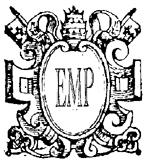EMP1294
Beata es virgo Maria
SSATBB
Marian Feasts
£4.00
EMP1306
Cantate Domino
SAATTB
Motet general, Non-liturgical
£3.00
EMP1258
Confitebor tibi Domine a 13 (1615)
a 13: see description
Respond, Office of the Dead
£6.30
EMP1275
Exaudi Deus à 12 (1615)
a 12: see description
Respond, Office of the Dead
£6.00
EMP1681
Exaudi Deus à 12 (1615)
a 12: see description
Respond, Office of the Dead
£4.75
EMP1682
Exaudi Deus à 12 (1615)
a 12: see description
Respond, Office of the Dead
£4.00
EMP1683
Exaudi Deus à 12 (1615)
a 12: see description
Respond, Office of the Dead
£4.00
EMP1684
Exaudi Deus à 12 (1615)
a 12: see description
Respond, Office of the Dead
£4.00
EMP1685
Exaudi Deus à 12 (1615)
a 12: see description
Respond, Office of the Dead
£25.50
EMP1307
Exaudi Domine
SAATTB
Motet general, Penitential
£3.00
EMP1274
Exaudi me Domine a 16 (1615)
Four choirs
Respond, Office of the Dead
£6.00
EMP1276
Jubilate Deo a 10 (1615)
a 10: see description
Respond, Office of the Dead
£7.10
EMP1686
Jubilate Deo a 10 (1615)
a 10: see description
Respond, Office of the Dead
£22.50
EMP1251
Magnificat a 14 (1615)
14 parts: see description
Vesper Canticle, General Use
£7.10
EMP1690
Magnificat a 14 (1615)
14 parts: see description
Vesper Canticle, General Use
£13.50
EMP1259
Magnificat a 8 1597
SMAT ATTB
Vesper Canticle, General Use
£4.75
EMP1281
Magnificat a 8 1597
SMAT ATTB
Vesper Canticle, General Use
£4.75
EMP1318
Maria Virgo 1597
TrTrSMA TBBBF
Marian Feasts
£5.00
EMP1092
Miserere 1597
SATBaBaB
£4.00
EMP1256
O Jesu mi dulcissime 1597
SMAT ATTB
Christmas
£4.00
EMP1278
O quam gloriosa a 16
a 16: see description
Assumption BVM (August 15)
£6.30
EMP1287
O quam suavis 1597
SSAATBaB
Magnificat Antiphon, Corpus Christi
£4.00
EMP1288
O quam suavis 1597
SSAATBaB
Magnificat Antiphon, Corpus Christi
£4.00
EMP1249
Omnes gentes
a 16: see description
Ascension
£6.00
EMP1296
Quis est iste a 10
TrSMAT ATBaBB
Non-liturgical
£6.00
EMP1295
Sancta Maria succurre miseris
SAATTBB (bc)
Marian Feasts
£4.75
EMP0530
Lift up your heads O ye gates
SSAATB
Psalm-Motet, Advent
£4.00
EMP1290
Lift up your heads O ye gates
SSAATB
Psalm-Motet, Advent
£4.00
EMP0531
O Lord in thy wrath rebuke me not
SSAATB
Psalm-Motet, Penitential
£3.00
EMP0479
The Cries of London
SSATTB voices and viols
Secular
£4.75
EMP1607
The Cries of London
SSATTB voices and viols
Secular
£9.50
EMP0484
Song of the Cherubim (Izhe Cherubimi)1837
SSAATBBF
Motet general
£4.00
EMP0495
In die tribulationis meae
SATTB
Psalm, Penitential
£4.00
EMP0470
O Sapientia
SATBB
Magnificat Antiphon, Advent
£3.00
EMP0421
Rorate coeli
SSATBB
Introitus, Marian Feasts
£3.00
EMP0574
Two motets for Advent
various
Motet general, Advent
£4.00


